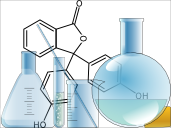A chemical killer app
Photocages have big potential in the world of pharmaceuticals
by Tom Mason

What is you could turn a chemical reaction off simply by flicking a lightswitch? That’s exactly what chemists are doing with a technology called photocages.
In chemical parlance, photocages are molecules that can be attached to another molecule and then removed again by irradiating them with light. Matt Lukeman, a chemistry professor at Acadia University in Wolfville, Nova Scotia is already well known in the narrow world of photocage research. “If you take a molecule that has a specific activity – a chemical activity or a biological activity – when you attach the photocage to it, it shuts that activity off,” he says. “When you hit it with light it causes the photocage to break off and that releases the molecule, which becomes active again. It’s a way of activating biological or chemical activity with light.”
Today photocages are used primarily by biochemists who study the rates of very fast biological processes: Drop an aspirin, start a stopwatch and time how long it takes for a headache to disappear, for example. That works fine in a reaction that takes 10 seconds or 10 hours. But some biological processes – the firing of nerve synapses in the brain, for example – are measured in milliseconds. The reaction is over before the scientist is finished injecting the drug.
With a photocage attached, the drug can be injected, allowed to defuse properly in the tissue and then reactivated with a short laser pulse. Scientists who are timing a rapid chemical or biological reaction can use a computer apparatus that has a laser light at one end and a measuring device on the other. The most sophisticated machines can send laser pulses with bursts that last just 10 nanoseconds – the time it takes for a beam of light to travel three meters.
Photocages have been used in this way since they were first developed three decades ago. But the real killer apps for photocages have yet to be developed. Chemotherapy drug photocages are one of the most exciting new possible uses. Traditional chemotherapy drugs do a good job at killing tumor cells. The problem comes from the fact that they also attack the healthy cells in the body. If a chemotherapy drug could be developed that could be activated and deactivated by a photocage, it would be possible to inject the drug, blast the tumor with UV light and activate only the drug that comes in contact with the light – and the tumor.
Since they were developed, one photocage – a compound known as the orthonitrobenzyl group – has been used almost exclusively. Despite its status as the workhorse of photocages, orthonitrobenzyl has its drawbacks, however. It’s not particularly water-soluble, has relatively slow release rates and it leaves a byproduct behind after it has been released. That’s where Lukeman comes in. He is working to develop a new generation of photocages that are faster and more accurate, sketching each one out on paper before he goes into the lab to actually produce it. “The end users of these products are biochemists, not photochemists,” he says. “They aren’t in the game of developing photocages. They want a ready-made product that they can use. I have a number of ideas that could work and one that has already shown a lot of promise.”
Lukeman estimates that it will be about five years before his first photocage is ready for commercial development.
